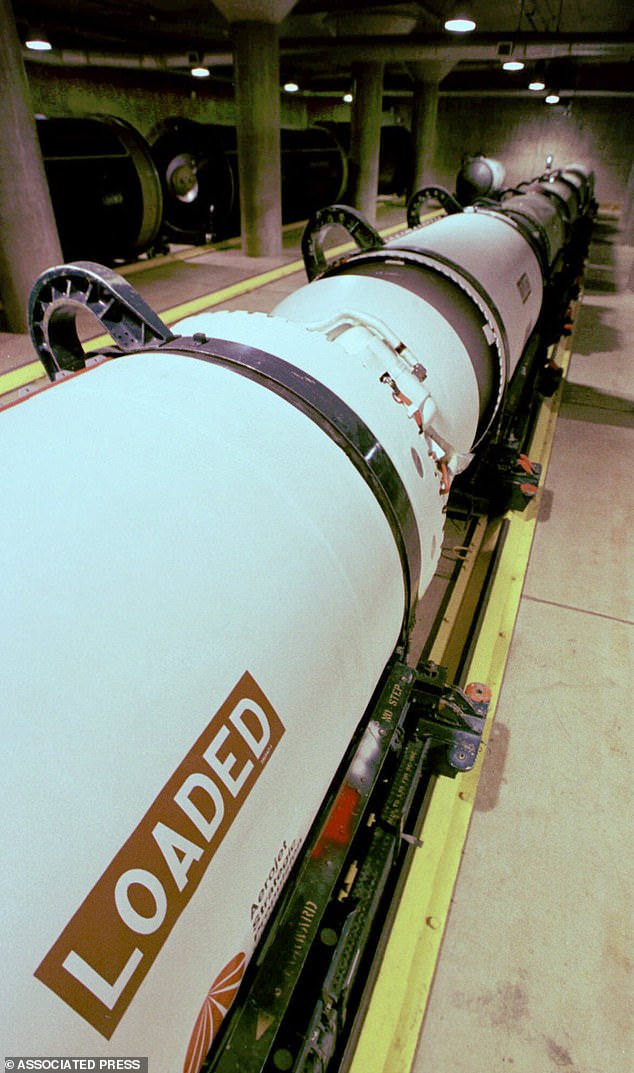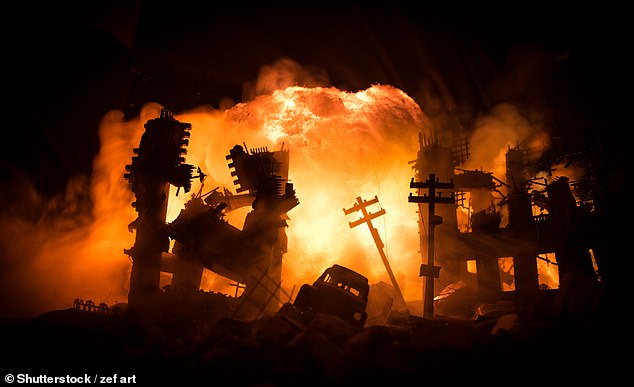Inside ‘Project Sentinel’ — the $300 Billion Plan to Upgrade America’s Doomsday Machines
They have been sleeping in hundreds of hidden places for almost 75 years, silently protecting Americans.
Now the country’s nuclear missiles are set to receive a $141 billion upgrade that will allow them to launch counterstrikes against adversaries such as Russia and China.
The plan, called Sentinel, aims to modernize the U.S. military’s 450 silos, build 3,000 miles of utilities and construct 62,000-foot-tall communications towers by 2036.
The cost could rise to more than $300 billion after Sentinel is completed, but officials have said the plan is “essential to national security” and offers “no alternatives” that would lower prices.
The Pentagon wants to modernize the Cold War-era intercontinental ballistic missiles (ICBMs) and the 450 operational launchers scattered across the country
The DOD has scheduled a hearing in Congress for July 24. The hearing will discuss plans to restructure 450 intercontinental ballistic missile (ICBM) launch sites and the weapons they house.
These silos are spread over 40,000 square miles in the northern Midwest, primarily in North Dakota, Montana, Colorado, Wyoming, and Nebraska.
The silos were built in the 1950s to store nuclear missiles, which could be launched quickly during the Cold War.
But the arsenals and launch facilities have not been modernized since then.
Dr. William LaPlante, who led the Defense Department’s investigation, said in a July 8 statement: “Sentinel is a truly historic program to modernize the Triad land force, the size, scope and complexity of which is something that we as a nation have not attempted in 60 years.
“Now that we have conducted a comprehensive and objective review of the program, it is clear that the Sentinel program remains essential to U.S. national security and is the best option to meet the needs of our warfighters.”
The Current State of America “The nuclear arsenal remains safe, secure, and effective,” the Pentagon report said.
However, most systems operate beyond their original lifespan, and there is little to no margin between the end of their effective lifespan and the time when they need to be replaced.
The study said the multibillion-dollar upgrades are needed to ensure no gaps remain in national security as America’s adversaries have poured even more money into keeping their arsenals up to date.

The ICBMs are spread across 40,000 square miles in the northern Midwest, primarily in North Dakota, Montana (pictured), Colorado, Wyoming and Nebraska.

These silos are spread across 40,000 square miles in the northern Midwest, primarily in North Dakota, Montana, Colorado, Wyoming and Nebraska.
Air Force Chief of Staff Gen. David W. Allvin said, “We face a changing and complex security environment marked by two major nuclear powers that are strategic competitors and potential adversaries.
While I have confidence in our current legacy systems, it is imperative that we modernize our nuclear Triad. A restructured Sentinel program is essential to ensure we remain best positioned to address future threats.
Sentinel is the DOD’s largest nuclear weapons project since the end of the Cold War, when the U.S. built a trio of ICBMs, SLBMs (submarine-launched ballistic missiles) and heavy bombers, giving the company an arsenal of 10,000 warheads.
The Air Force is expected to begin replacing its existing Minuteman III ICBMs in 2030, and while the Department of Defense expects this to cost $141 billion — an 81 percent increase from their 2020 projections — it will be completed in 2024. taxpayer analysis claimed the actual total cost was likely closer to $315 billion.
The original Minuteman silos were built so that the US could, if necessary, launch a nuclear strike on Russia or China, wiping out the entire population but also acting as a “nuclear sponge.”

The Air Force is expected to begin replacing its existing Minuteman III ICBMs in 2030, and while the DOD expects this to cost $141 billion — an 81 percent increase from their 2020 projections
The “nuclear sponge” theory is that ICBMs would destroy hundreds of nuclear warheads from an adversary like Russia before it could fire them at the US.
“When I was on the Armed Services Committee in the ’80s and ’90s, I heard about the sponge,” said Joseph Cirincione, a former congressional staffer who worked on military reform for nearly a decade. WIRED.
“It’s one of the two main justifications for the ICBM.”
The purpose of Sentinel is to complicate an adversary’s plans to attack the U.S. in such a way that the foreign government is deterred from attacking.
The response comes as China’s arsenal is growing rapidly, with the country on track to have at least 1,000 nuclear weapons by 2030, while Russia has the largest nuclear stockpile with 5,580.
While the plan is vital to American survival, experts warn that this so-called “doomsday machine” could kill more than 300 million people living around the launch sites.
The Ministry of Defense said in a report earlier this month that “the Sentinel program is essential to national security” and that there are risks associated with not updating the ballistic missiles.
“If we were to use ICBMs, it would mean the end of human civilization, even without an adversary hitting the US with a single warhead,” Cirincione said.
But when it comes to the number of deaths the ICBMs could cause, Princeton University principal investigator Sébastien Philippe told WIRED: “It’s not just about absorbing a nuclear attack.
“It’s like if you pour water on the sponge and then press it, it will splash everywhere. So the splashes from that sponge are huge radioactive fallout all over the country,” he continued.
‘We’re not talking about getting cancer in 15, 20 or 30 years.
“We’re talking about your cells, your organs and your body shutting down within days, weeks or months after the explosion.”
The airforce revealed In March, nearly 200 missile officers serving at Malmstrom Air Force Base in Montana, which is near a silo site, were diagnosed with cancer, and at least 23 of them had non-Hodgkin lymphoma, a form of blood cancer.
Researchers from Princeton University’s Science and Global Security Program have examined the implications of the “human and environmental risks associated with the Sentinel missile program.”
They said there were “catastrophic risks” associated with deploying ICBMs.
The rockets would also generate hazardous waste that could contaminate water streams with asbestos, lead-based paint and polychlorinated biphenyls.
According to a Princeton University study, these chemicals have been linked to liver and kidney damage, cancer, and immune and reproductive problems. study.

Experts have warned that if the nuclear missiles are deployed, about 300 million people will be exposed to radioactive material within months of the explosion, causing the body’s cells and organs to shut down.
Researchers also reported that the U.S. Air Force found unsafe levels of a possible carcinogen at underground launch sites in Montana.
Many have opposed the administration’s plans, including former Defense Secretary William Perry, who warned that the ICBMs should be eliminated by 2016. Opinion piece in the New York Times.
He called the missiles “some of the most dangerous weapons in the world,” adding that “they could even cause an accidental nuclear war.” He also described a false alarm he received when a computer glitch indicated that 200 Russian nuclear missiles were headed toward the United States.
The U.S. Air Force released an environmental impact statement in March last year stating that land-based missiles and silos “contain no nuclear material,” even though each missile is built with a warhead with an explosive force equivalent to hundreds of thousands of tons of TNT.
“Russia and the United States have already been through a nuclear arms race. We have spent trillions of dollars and taken incredible risks in a misguided quest for security,” Perry wrote in the op-ed.
He added: “There is only one way to win an arms race: refuse to participate in it.”
A Pentagon spokesman declined DailyMail.com’s request for comment on the claims, saying “more information will be made available as the program’s restructuring progresses.”
